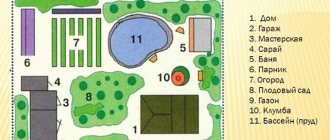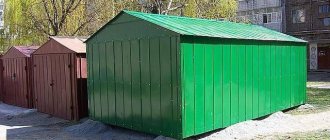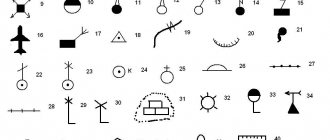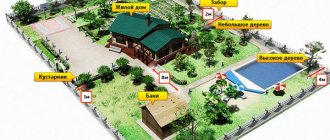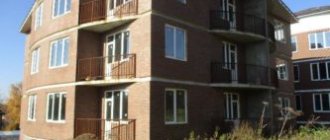The red development line is a special design boundary line that separates a plot of land allocated for development from public areas. On project maps this line is indicated in red, hence the name.
In accordance with the Town Planning Code, these lines also mark areas where it is planned to develop various promising projects in populated areas under construction.
Fulfillment of necessary conditions during construction
Many owners of private territories are interested in what the red development line is. When erecting buildings, before starting work, it is necessary to decide where the red building line is planned. Activities for the construction of private houses and public buildings should not be carried out in any order.
State standards recommend that objects be located within the exact limits of the red lines. The distance to them should be at least 2 - 3 meters. There are exceptions for some buildings - these are buildings that have premises for public needs on the ground floor. Such objects can be placed directly on this line.
Houses that go beyond the red lines and development control lines may be subject to demolition by court order. Privatization of buildings installed in violation of the approved boundaries is not permitted by law, as stated in the Land Code of the Russian Federation, Article 85, paragraph 12.
How to determine the red line of a street
Why is the red building line necessary?
When drawing up a construction plan, the concept of a red building line is very often used. This is a special mark that is considered the main one in a specific area of the terrain. Therefore, if the owner of the site is going to erect buildings, he should definitely take into account the red line.
The Town Planning Code provides for the use of the concept of a red line on all areas that in the future are planned to be used for mass development in a populated area.
What is a street red line??
Hello friends! I am glad to welcome you to the pages of my blog. Today we will talk about what a street red line is.
It is also quite popular, especially in an ancient city, which may be located in a warm climate zone near trade land and waterways, to use radial street placement. That is, the paths are clearly directed on different sides from a single center point. This point can be palaces, temples, squares or markets, which are usually located in the middle of the square.
What are red lines and why do you need to know where they are?
When registering rights to land plots and obtaining construction permits in the city of Tula, architects, cadastral engineers, and government officials often use the concept of “red lines”. The purpose of this article is to understand what red lines are and what they affect.
Definition of the "red line". Red lines are lines that indicate existing, planned (changed, newly formed) boundaries of public areas, boundaries of land plots on which power lines are located, communication lines (including linear cable structures), pipelines, roads, railway lines and other similar structures (linear objects).
Red lines separate public (public) areas from land plots developed by private individuals. In other words, the red line separates public lands (places) (streets, alleys, driveways, etc.) from city blocks.
How to draw red lines?
| | 05/27/2015 | Veronica Bozhuk defines red lines as follows: Red lines are lines that designate existing, planned (changed, newly formed) boundaries of public areas, boundaries of land plots on which power lines are located, communication lines (including line-cable structures) , pipelines, roads, railway lines and other similar structures (linear objects).
Thus, “in the red lines” are the streets, and “beyond the red lines” are the neighborhoods. Before the current Town Planning Code was issued on December 29, 2004, the situation was different. Red lines were the boundaries separating the territories of blocks, microdistricts and other elements of the planning structure from streets, driveways and squares in urban and rural settlements.
Those. Until 2004, the territory “in the red lines” meant neighborhoods. Red lines are established by the territory planning project.
What is a street red line?
Architecture and urban planning are among the most ancient industrial sectors, where compliance with all legislative, technical, functional and operational standards and regulatory restrictions is mandatory. Each nation today has its own traditions of the location and mutual localization of streets, squares and other elements of urban planning:
- No less often, especially in ancient cities located in warm climatic zones near trade land and waterways, a radial arrangement of streets occurs when they diverge in different directions from one center.
- In relatively new urban formations, this is generally a rectangular arrangement, where the streets are strictly perpendicular to each other and the intersections form clear right angles.
Determining the location of the red line
The main function of the red line is to determine the boundaries of land plots. According to the law, it is outlined for the purpose of establishing restrictions and separating private land plots from public areas.
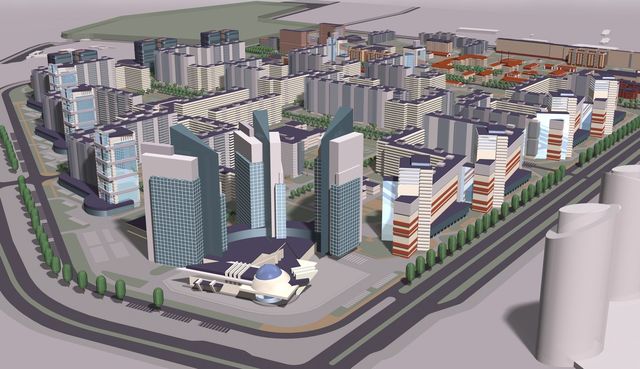
Allotments of land may include separate plots marked with red lines:
- Electrical communication lines.
- Engineering Communication.
- Location of pipelines.
In these places, even on private privatized plots, construction is not allowed. To obtain comprehensive information about the actual location of the red line on the general development plan, you must contact the cadastral chamber. Red building lines are reflected in the following documents:
- general plan;
- land and urban planning cadastre;
- development project;
- detailed planning;
- design of the location of streets, highways, squares;
- engineering communications;
- transport lines.
The location of the red lines is agreed upon and approved during the development of all urban planning documentation.
Kinds
Not all red contours on the territory diagram have the same legal force. There are several types that differ in purpose and significance.
Design
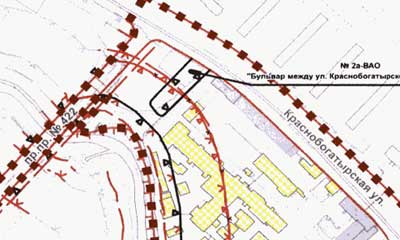
If the construction of facilities or the allocation of territory for public use is only in the plans of the authorities, then a design red line will appear on the development plan.
It means that regional authorities intend to further use the specified territory.
However, such lands have not yet been alienated, which means that such a border has no legal force .
The project line is intended to bring to the attention of the public that in the future the territory will be transferred to the category of public land. However, when this will happen is unknown.
It is possible that the authorities' plan will not be implemented, and the designation will soon disappear from the development plan. Therefore, the project line should not be considered an object subject to cadastral registration .
Typically, designations that have not yet been adopted follow the existing boundaries of the land plot.
Existing
If the objects that need to be separated from the surrounding privatized territories and state property have already been built and are operating, then their boundaries are indicated by the existing red line.
Its consolidation is evidenced by an approved normative act that makes the boundaries legally significant. The exact coordinates of a line of this type are marked on the development plan and recorded in the cadastral registration authorities.
Even if all the plots of land that are located around the territory enclosed in the red outline are officially registered with the Cadastral Chamber and have boundaries established during boundary work, the red line will still be more significant. The extreme points of the plots should not protrude beyond its limits .
Location of possible development line
A building line is necessary to determine the area where a building can be erected. The boundaries within which construction is permitted, in most cases, deviate from the red line. The territories located between the building and the red line belong to the land owners. These distances are regulated by Building Codes and Rules (SNiP 2.07.01-89, paragraph 2.14) and the Town Planning Code.

Residential buildings with apartments on the ground floor are required to be located with a mandatory deviation from the red line. On personal plots, the distance from the house to the edge of the sidewalk should be 4 - 5 meters. This indentation value is necessary to ensure the following conditions:
- Separation of residential premises from dust.
- Penetration of noise from the street into the house.
- Organizing the most comfortable space.
The construction of new buildings is carried out with mandatory observance of the location of building lines and red lines. To obtain a building permit, you must present a diagram or plan that shows how the site will be organized. This plan outlines the following data:
- boundaries of the land plot;
- how the red lines are located;
- where the building lines of the future building are located.
There are isolated cases when the building lines coincide with the red lines.
LINES OF URBAN PLANNING REGULATION.
City regulation lines are the boundaries of territories within which special regimes and rules for their use operate in accordance with regulatory requirements.
Project plan for city lines. regulation is an integral part of the approved city. documentation, in cat. current and proposed city lines are reflected. regulation.
To the hail lines. regulations include:
-Red lines - lines, cat. denote noun, planned, newly formed, change. boundaries of public territories use, boundaries of the territory of the road network, power lines, drugs, pipelines, railway lines, etc., separated from the rest of the city. Buildings and structures should not protrude beyond the red lines towards a street or square.
-Residential development line - a line that limits the placement of residential buildings, structures, ground structures, and is distant from the red line at a distance determined by urban planning standards.
-Blue lines are the boundaries of river water areas, as well as existing and projected open reservoirs, established along the normal retaining horizon (NRH).
-The boundaries of the right-of-way of railways are the boundaries of the territory intended for the placement of existing and projected railway tracks, stations and other railway structures, the width of which is standardized depending on the category of railways, the design of the roadbed, etc., and on which the construction of buildings and structures not related to the operation of railway transport.
-The boundaries of technical zones of metro lines under construction and design are the boundaries of territories reserved for the construction of shallow metro lines and accompanying structures of a permanent nature, on which the construction of capital structures is prohibited.
-The boundaries of technical zones of operating metro lines and structures are the boundaries of the territories on which operating shallow metro lines and accompanying structures are located, on which economic activity is permitted only in agreement with the organization operating the metro.
-The boundaries of technical (security) zones of existing and designed engineering structures and communications are the boundaries of territories intended and used for the construction and operation of surface and underground transport and engineering structures and communications.
-The boundaries of the territories of immovable historical and cultural monuments are the boundaries of specially protected land plots that are historically and functionally connected with immovable historical and cultural monuments and are their integral part, taking into account the modern urban planning situation.
-The boundaries of protective zones of historical and cultural monuments are the boundaries of territories immediately surrounding the territory of an immovable historical and cultural monument, intended to ensure the safety of the monument and its aesthetic perception, with a particularly strict regime for land use.
-The boundaries of historical and cultural protected areas are the boundaries of territories that include ensembles and complexes of historical and cultural monuments that represent special historical, scientific, artistic and other cultural value, the protection of which is carried out on the basis of a special provision for each of them.
-Borders of zones regulating the development of historical and cultural monuments - the boundaries of the territories surrounding the security zone of an immovable monument, necessary to preserve or restore the nature of the historical layout, spatial structure, originality of the architectural appearance, to consolidate the significance of the monument in the building or landscape, to ensure the architectural unity of new buildings with the historical environment. Within the boundaries of these territories, restrictions on new construction are established, requirements for the reconstruction of existing buildings and a regime for regulating economic activity are determined.
-The boundaries of protected urban and natural landscape zones are the boundaries of territories established to preserve the valuable architectural and natural landscape of Moscow (relief, reservoirs, historical and urban environment, green areas) with a regime for regulating urban planning activities and new construction on this territory.
-The boundaries of specially protected natural areas are the boundaries of the city’s territories with natural objects located on them that have special environmental, scientific, cultural, aesthetic, recreational and health value, on which, in accordance with the legislation, a special protection regime has been established.
-The boundaries of protective zones of specially protected natural areas are the boundaries of zones with a limited regime of environmental management, established on areas of land and water adjacent to specially protected natural areas.
Contents of the Civil Code
The Civil Code of an object at any territorial level contains information:
— on town planning regulations;
— about the condition and use of the territory, external conditions;
— about the urban planning value of the territory;
— about general legal and regulatory documentation on urban planning related to a given territory, about design and survey documentation related to a given territory;
— on state authorities and local self-government, legal entities and individuals who have the authority to own, use and dispose of territorial elements, facilities, communications, and are responsible for compliance with urban planning regulations.
Urban planning regulations are characterized by the types and parameters of changes in the state and use of the territory, valid within a specified period. The basis for registration of regulations is approved urban planning documentation and other mandatory design and regulatory documents. Information on urban planning regulations is presented by zones, other territorial elements, and objects to which these regulations apply. The state of the territory is characterized by the composition, spatial distribution, quantitative and qualitative indicators of its components.
The use of the territory is characterized by the composition of functions, their spatial distribution, quantitative and qualitative indicators of their impact on the environment. External conditions are characterized by spatial distribution, quantitative and qualitative indicators of the influence of infrastructural resource, environmental and other environmental factors on the territory.
The urban planning value of the territory is expressed by comparative conditional indicators. Characteristics of the actual state and use of territories and external conditions are given in the form of indicators comparable to the indicators of urban planning regulations.
Determination of minimum fire distances
To ensure fire safety, it is allowed to design and construct buildings at an average distance from each other of 6 - 15 meters. The minimum fire safety distance depends on the materials from which the load-bearing external walls and ceilings of neighboring houses are made. State building regulations provide for the required distances between residential buildings:
- If the walls of neighboring buildings are built from non-combustible materials - concrete, stone, reinforced concrete, brickwork, the minimum fire-prevention distance between them is 6 meters.
- If they have wooden floors - 8 m.
- For wooden houses or those built from other combustible materials - 15 meters.

All calculated distances are measured at the most prominent points. Most often this is a porch or bay window.
Regulatory documents contain recommendations - to place residential buildings offset to the lateral boundaries of land plots. If this condition is met, it will be more convenient for the owners to carry out repair work later. The minimum distance from the outer wall of the building to the fence of the site is 1 - 1.5 meters.
It is recommended to erect buildings for utility purposes in the depths of the plots, separately from residential buildings, at an average distance of 5 meters. Natural wells, composting facilities, summer showers, outdoor toilets, etc. - no closer than 8 meters. The distance to electrical and telephone cables is 60 cm.
To avoid violating the border, when designing and constructing a garage, the distance to the red line is measured with the entrance gate open. It is also necessary to mark the location of the external fence on the project.
Buildings intended for keeping pets or birds can be attached to a residential building. In this case, it is necessary to separate them from the living rooms of three utility rooms (no less). The height of these extensions should not exceed 2.4 meters.
In addition to mandatory standards, there are also additional restrictions on the planning and development of territories for low-rise buildings. These include the requirement to ensure a distance of at least 4 meters between the walls of neighboring buildings and the windows of the residential premises of a given private house.
The commissioning of a new house will be carried out without additional problems if, during its design and construction, all necessary standards regarding distances between neighboring objects are met.
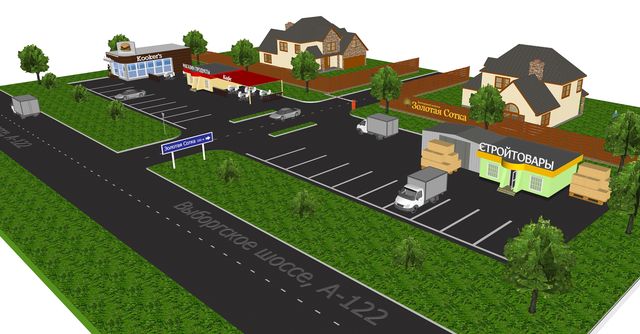
Legislative acts regulating construction in settlements
Indeed, the red line for individual housing construction is one of the main conditions, if not met, court decisions can be expected to demolish the constructed facility.
So, what is this term “red line”? And what does this term mean?
Many people mistakenly believe that the red line marks the boundaries of land plots. But this is not entirely true. Yes, the red line sets the boundaries of the streets and alleys of any settlement. But it is also one of the main regulatory conditions when developing a plan for building a house on your site.
The Town Planning Code of Russia has given a clear definition to this concept. This is the line dividing ownership of land plots and public areas. Public areas are places where any citizen of Russia has the right of access. This is a street, alley, square, park and any area.
The same basic urban planning document prohibits unauthorized development of any objects beyond the red line, that is, on the street, since this is the territory through which power and communication lines, automobile, tram and railway tracks, pipelines, and so on pass. Therefore, any construction on these territories in accordance with the Land and Town Planning Codes requires special permission.
Where are red building lines used?
Compliance with the boundaries marked by the red building line is a necessary condition when carrying out the following activities:
- construction of buildings and structures;
- creation of construction projects;
- development of new territories allocated for development;
- land surveying;
- inventory of plots with various buildings located on them;
- registration of real estate as personal property;
- assignment of the right to dispose or use real estate.
The location of the red lines must be taken into account when drawing up and processing various documents:
- Development of plans for specific territories.
- Description of the rules for using land plots.
- Allocation of part of the territory for new construction.
- Drawing up a Master Plan for the construction of buildings.
If existing documents do not have red lines, their location must be marked and approved in the proper order.
This is done by qualified employees of municipalities; they establish legal acts in accordance with current regulations. The document drawn up during the approval process of the red line refers to regulatory legal acts (RLA). It is open for public inspection.
Red lines and legislation
The red lines of roads and streets are determined by the Town Planning Code of the Russian Federation (GrK RF). According to subparagraph 11 of Article 1 of this document, such boundaries should be understood as a line that defines the territory for the use of an unlimited number of persons. These can be squares, streets, driveways, squares, embankments, boulevards, etc.

The red line of the street is a plot of land that is part of the documentary planning of the territory (Chapter 5 of the Civil Code of the Russian Federation). It is contained in master plans, diagrams and maps of current and planned boundaries of city zones.
The width of the red lines of the street determines the configuration of the boundaries of land objects. This is stipulated in paragraph 7 of Article 36 of the Land Code of the Russian Federation (LLC RF).
The distance of these street fences is determined by the Instruction on the procedure for designing and installing red lines in cities and other settlements of the Russian Federation. It operates in accordance with the approval of the Decree of the State Construction Committee of the Russian Federation dated 04/06/1998 No. 18-30, which does not contradict the Civil Code of the Russian Federation.
Mechanism of use
The standards for the placement of houses and utility blocks are regulated by the provisions of the Town Planning Code. Their explanation and definition is found in the building codes in accordance with the issues that arise. This means that inside his own plot, the owner cannot, at his own discretion, place a house and barn in any place he likes.
Until 2020, there was an unspoken amnesty, which involved the legalization of unauthorized buildings by local governing bodies. The attitude towards regulatory requirements was lenient. Recently, in order to formalize documents for a building that has already been erected without permission, a decision from the judicial system is required.
The jury does not always make a positive verdict and in its work is guided by the rules and regulations of the development. This leads to the fact that the built house or utility blocks may be intended for demolition. Such decisions are made even in cases where the land is privately owned.

There is a mechanism for determining the red line
The owner of a plot of land encounters the concept of a red line at the initial stage of obtaining a permit and developing a project for individual construction of a house. Further passage of the authorities goes according to plan, and the owner of the site provides the local municipality with:
- A cardinal plan of the land plot with the connection of the structure under construction to the existing terrain and the red line on the general plan indicated on it. Attaches a cadastral passport of the land.
- A photocopy of the urban planning map with the outline of those boundaries, taking into account which the location of the building is selected.
- A site development plan, professionally or in-house, with the distance marked from the red line of streets and alleys to the border of the future house. On the schematic representation of the plot attached to the cadastral certificate, the required line is not shown.
- A note with explanatory text.
After accepting the package of necessary papers, the local government authority issues a permit to build a house.
Regulations
Before determining the red line of a site for a number of village plots for construction, the relevant documentation is put in order. This includes the following papers:
- SPOZU is a schematic layout for organizing a plot of land. Before the construction of the house begins, the document records the position of the red border, which determines the permitted territory for construction.
- GPZU is an urban planning project for an allotment that defines in detail the outlines of the future development of the microdistrict.
Topographical identification elements are drawn on a photocopy of the required section of the map, which are located in the designed area. These include:
- high-rise buildings;
- sports and cultural buildings;
- squares;
- lawns, parks;
- streets and neighborhoods;
- roads and passages.

The task of the department of urban or regional architecture is the successful location of the real estate object, its harmonious fit into the landscape of the territory permitted for development. The customer collects the necessary documents indicating the place of housing, applies to the municipality to obtain a permit, builds a house taking into account the drawing and project.
Responsibility for breaking a trait
Basing a building on a site that deviates from the regulatory requirements specified in the project leads to the recognition of illegal development if the distances from the red contour are not observed. In most cases, responsibility is administrative in nature.
Options for demolishing a new building are also common if the size of the deviation from the rules requires it. Sometimes the decision to dismantle comes as a result of legal proceedings.
House location standards
Constructions are not only located inside the territory marked with a red line. They are provided with a certain distance. Basic rules for the location of buildings relative to the boundary line:
- The fence protecting the yard space may coincide with the boundary, but the building itself must retreat from it by five meters. This rule is valid for a boundary if it separates a street and a plot of land. The concept of street includes a carriageway and a pedestrian sidewalk.
- If the boundary of the site does not coincide with the red border, then the minimum distance to it is three meters.
- Large trees should not be planted closer than four meters.
- Shrubs taller than half a meter are located no closer than five meters from the road.
- Tall vegetation should not obstruct the passage of ambulances and fire trucks. Plants should not interfere with the lighting of the home.
- For buildings in which public services and shops are located on the ground floors, other placement rules are provided. Their front wall may coincide with the red line.
- When calculating the distance to the red line of the road, not only the walls of the house are taken into account, but also its protruding structural elements. This is taken into account at the design stage, since the regulatory gap may be violated by a wide roof overhang.
- Outbuildings are usually located in the depths of the land plot. But if the red line runs close to them, then the location of the blocks is also subject to regulatory rules.
- Outbuildings are tripled so that the distance between their walls and the fence is at least one meter.
- If the red border passes inside the land plot, any construction on the site is not permitted.
Requirements for the installation of fencing
The norms for the distances of fences from the red boundary are different and depend on their location on the plan. For protective fences of the yard area running next to the control line , the following requirements apply:
- The installation location will be agreed upon with the city management committee for architecture and construction.
- It is not permitted to use hazardous materials that could cause injury to passers-by for the construction of the fence. These include unplaned boards, hazardous waste, barbed wire, etc. There are no restrictions for other certified materials.
- The height of the protective barrier should not exceed 2.2 m.
- When the fence is located along the street, the leaves of the gate and entrance gate to the site are allowed to be hung with opening inward. For external opening, there is a requirement that the fence be located at a distance of at least one meter from the limiting red line.
Failure to comply with the standards for the location of the fence leads to an administrative fine. The state agency for supervision of construction or the owner of a neighboring plot can certify and present violations if his rights of ownership are violated as a result of improper construction of the fence.
The size of the fine depends on the size of the deviation from the rules. The protective structure may be declared invalid. The owner will dismantle it using his own funds. Before starting construction of housing on the land, you need to complete the required documentation. Because of such actions, conflicts with supervisory authorities and neighboring owners will be reduced to zero.
